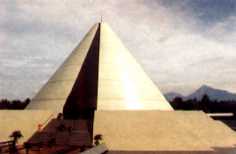|
Monuments
 THE TUGU MONUMENT THE TUGU MONUMENT
One of the monuments that stands as a quiet
witness to the development of Yogyakarta is called the Tugu, which
means column. The original Tugu was built to commemorate the
establishment of the Ngayogyakarta Sultanate in 1755. It once
collapsed and was replaced by a new one in 1889, shaped differently
from the original cylindrical Tugu.
Leading
southward from the Tugu towards the Sultan’s Palace is Mangkubumi Avenue and, after the railroad
station, Malioboro Street. Both sides of the streets are decorated
with artistic lamps and beautifully arranged small parks. In the
olden days Malioboro was famous as the defense base for the
Indonesian guerilla fighters in their attempt to defend the
independence of Indonesia against the Dutch.
Nowadays
Malioboro is well known as a gathering place for artists and
craftsmen. At night this main street is always crowded with people
selling Yogyakarta's specific food, called "gudeg", and other Javanese foods. Customers can sit and relax on a
mat while enjoying their food in Javanese tradition.
THE
MONUMENT OF MARCH
1st
 The Monument of
March 1st is located next to Fort Vredeburg
and was erected in commemoration of the total offensive on March 1,
1949 (Serangan Oemoem 1 Maret), when the Indonesian guerilla
fighters succeeded within 6 hours to reoccupy Yogyakarta, against
the Dutch colonial. The Monument of
March 1st is located next to Fort Vredeburg
and was erected in commemoration of the total offensive on March 1,
1949 (Serangan Oemoem 1 Maret), when the Indonesian guerilla
fighters succeeded within 6 hours to reoccupy Yogyakarta, against
the Dutch colonial.
This event, known as "the six
hours in Yogyakarta", was commanded by Kolonel Soeharto, who later
became the President of the Republic of Indonesia. Both parties were
brought to the Round Table Conference (KMB) in Den Haag.
 YOGYA KEMBALI
MONUMENT YOGYA KEMBALI
MONUMENT
Located approx. 7 km from the
Tugu Monument, the Yogya Kembali Monument (Back to Yogya Monument)
is built to commemorate the release of Yogyakarta from the Dutch in
1949.
Cone-shaped and three stories
high, this monument is built according to Kraton's architectural
philosophies. The ground floor has doors alligned east and west,
corresponding to the earth's rotation; the second floor has doors
alligned north and south. The third floor can be entered from the
floor below and consists of only one room: the meditation room. The
one hole in the roof lets sun light through. Toilets, souveniers,
and a cafe can be found on the ground floor.
Hours:
Tuesday through Sunday, 8 a.m. - 5 p.m.
Tariff: Domestic Rp1050; Foreign Rp1500
 
 
| 
